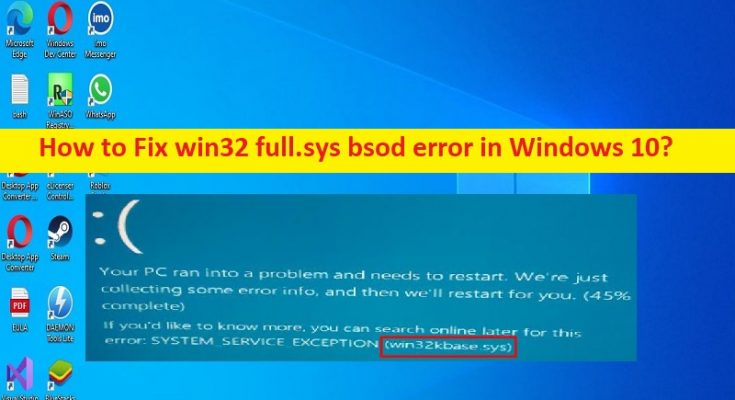What is ‘win32 full.sys bsod error’ in Windows 10?
In this article, we are going to discuss on How to fix win32 full.sys bsod error in Windows 10. You are provided with easy steps/methods to resolve the issue. Let’s starts the discussion.
‘win32 full.sys bsod error’:
It is common Windows Problem considered as Blue Screen of Death (BSOD) error. The BSOD error is appeared with messages saying ‘Your PC ran into a problem and needs to restart. We’re just collecting some error info, and then we’ll restart for you’ along with some Windows Stop Codes like SYSTEM_SERVICE_EXCEPTION (win32kbase.sys), APC_INDEX_MIXMATCH, PAGE_FAULT_IN_NONPAGED_AREA, STOP 0x0000001E: KMODE_EXCEPTION_NOT_HANDLED – win32kfull.sys, and STOP 0x0000000A: IRQL_NOT_LESS_EQUAL – win32kfull.sys.
The BSOD error is usually appeared in the middle of your work on computer or when you start/restart your computer. There could be several reasons behind the issue including corrupted/outdated device drivers, faculty RAM or memory, corruption in system files or registry, malware or viruses infections in computer, issue with hardware attached recently or software installed in computer.
You should make sure all device drivers are properly installed and are up-to-date to latest & compatible version in computer. If not, device driver update is necessary in computer if you don’t want to face this type of issue. It is possible to fix the issue with our instructions. Let’s go for the solution.
How to fix win32 full.sys bsod error in Windows 10?
Method 1: Fix ‘win32 full.sys bsod error’ with ‘PC Repair Tool’
‘PC Repair Tool’ is easy & quick way to find and fix BSOD errors, DLL errors, EXE errors, problems with programs/applications, malware or viruses infections in computer, system files or registry issues, and other system issues with just few clicks.
Method 2: Update Device Drivers
Updating all necessary device drivers to latest & compatible version can resolve the issue. You can use Automatic Driver Update Tool for this – offers you to update all Windows drivers including graphics card driver, sound card driver, and other device drivers in computer. You can get this tool through button/link below.
Method 3: Update Windows OS

Updating Windows OS to latest version can resolve the issue.
Step 1: Open ‘Settings’ app in Windows PC via Windows Search Box and go to ‘Update and Security > Windows Update’ and click ‘Check for updates’ button
Step 2: Download and install all available updates in computer and once updated, restart your computer and check if the issue is resolved.
Method 4: Run SFC Scan

You can run SFC scan in computer to repair corruption in system files in order to fix the issue.
Step 1: Type ‘cmd’ in Windows Search Box and press ‘SHIFT + ENTER’ keys on keyboard to open ‘Command Prompt as Administrator’
Step 2: Type ‘sfc /scannow’ command and hit ‘Enter’ key to execute. Once executed, restart your computer and check if the issue is resolved.
Method 5: Uninstall problematic software
This issue can be occurred due to some problematic software installed in computer or issue with recently installed software. You can uninstall recently installed software or problematic software in order to fix, and then check if the issue is resolved.
Step 1: Open ‘Control Panel’ in Windows PC via Windows Search Box and go to ‘Uninstall a Program > Programs & Features’
Step 2: Find and right-click the problematic software or recently installed application, and select ‘Uninstall’ to uninstall it, and after that, restart your computer and check if the issue is resolved.
Method 6: Run Windows Memory Diagnostic Tool
You can run Windows Memory Diagnostic Tool in computer in order to fix RAM and memory issue.
Step 1: Open ‘Windows Memory Diagnostic’ tool in Windows PC via Windows Search Box
Step 2: Click ‘Restart Now and check for problems’ option and wait to finish scanning and repairing process. Once done, check if the issue is resolved.
Method 7: Run Blue Screen Troubleshooter
Windows built-in Blue Screen trooubleshooter can resolve the issue.
Step 1: Open ‘Settings’ app in Windows PC via Windows Search Box and go to ‘Update & Security > Troubleshoot > Additional Troubleshooters’
Step 2: Find and click ‘Blue Screen’ troubleshooter, and click ‘Run the troubleshooter’ and follow on-screen instructions to finish troubleshooting. Once done, check if the issue is resolved.
Method 8: Perform System Restore
If the issue is still persist, you can perform System Restore in computer in order to restore your computer to valid restore point and fix the issue.
Step 1: Press ‘Windows + R’ keys on keyboard, type ‘rstrui’ in ‘Run’ window and hit ‘Ok’ button to open ‘System Restore’ app
Step 2: Click ‘Next’, select a valid restore point according to date & time when there was no issue at all in computer, and then click ‘Next > Finish’ to start restoring process and once finished, check if the issue is resolved.
Conclusion
I am sure this post helped you on How to fix win32 full.sys bsod error in Windows 10 with easy ways. You can read & follow our instructions to do so. That’s all. For any suggestions or queries, please write on comment box below.



